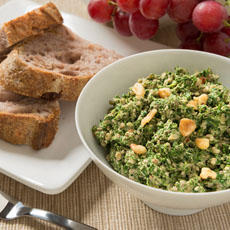RECIPE: Pxali, Georgian Spinach Dip With Walnuts
|
Americans love creamy spinach dip, sometimes made with added artichoke hearts (here’s a rich and lovely spinach and mascarpone dip recipe). But there are other types of spinach dip, some even better for you. Here’s a Georgian-style dip—actually more of a spread, which is chock-full of walnuts for protein and made with no cholesterol or added fat. That’s Georgia, the country in the Caucasus region of Eurasia, and part of the former Soviet Union. This recipe was created by California-based chef Boris Portnoy for the California Walnut Board. Chef Portnoy, of Georgian ancestry, notes that this dish originated in Georgia but has been adopted in other parts of the Caucasus. The name for the spread is pxali, a general term denoting a spread or dip that can be made from a variety of vegetables. Spinach is traditional. The dip is green if spinach is used, red if beet leaves are used or white if young cabbage leaves are chosen. |
A different type of spinach dip. Photo courtesy California Walnut Board. |
|
|
Whatever the vegetable, the dip/spread is always bound with a rich walnut paste into a thick mass, which can be used as a side dish at dinner or a main dish for lunch served with bread or lavash. It is best made a day ahead, so the flavors can develop more fully. Ingredients For 8 Servings |
||




